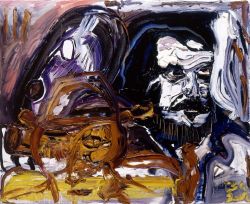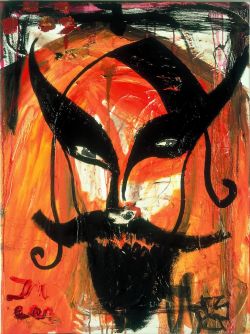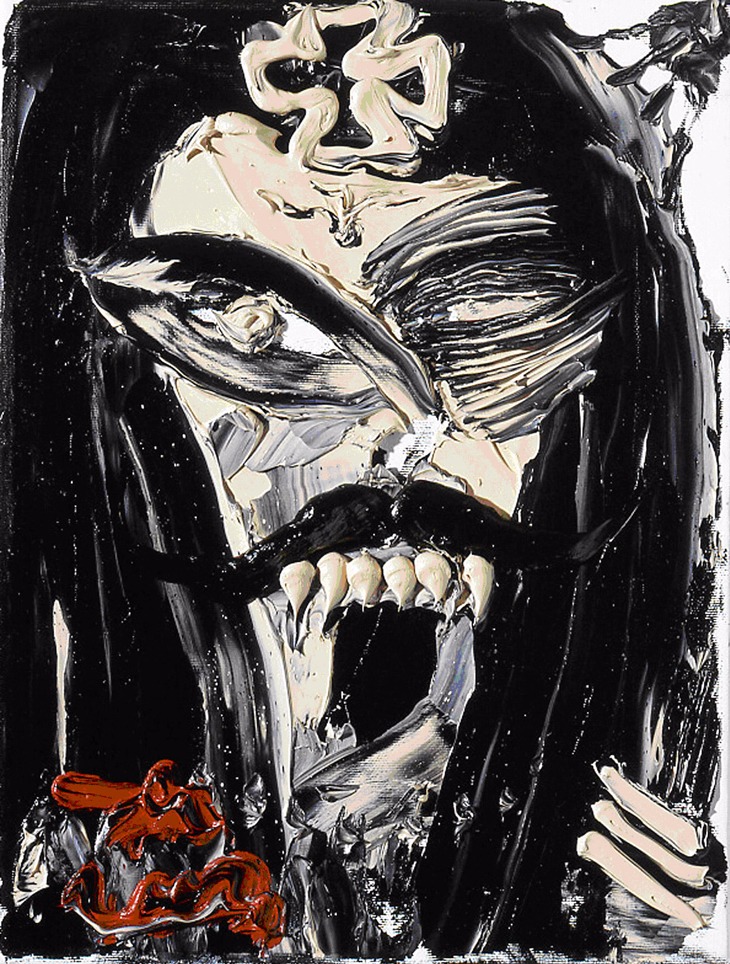


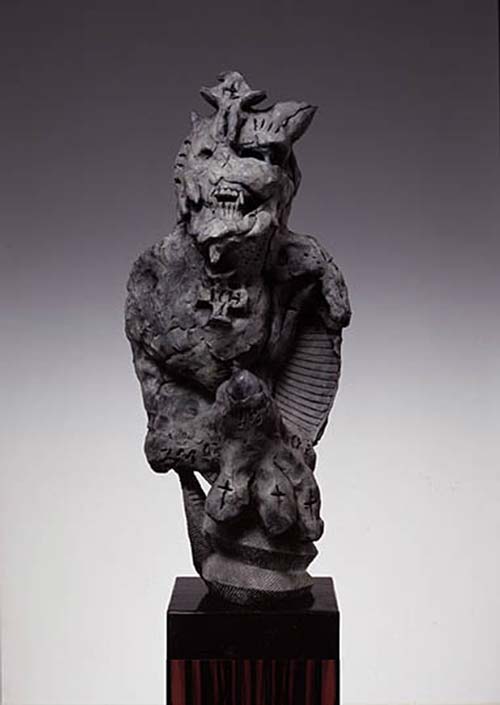

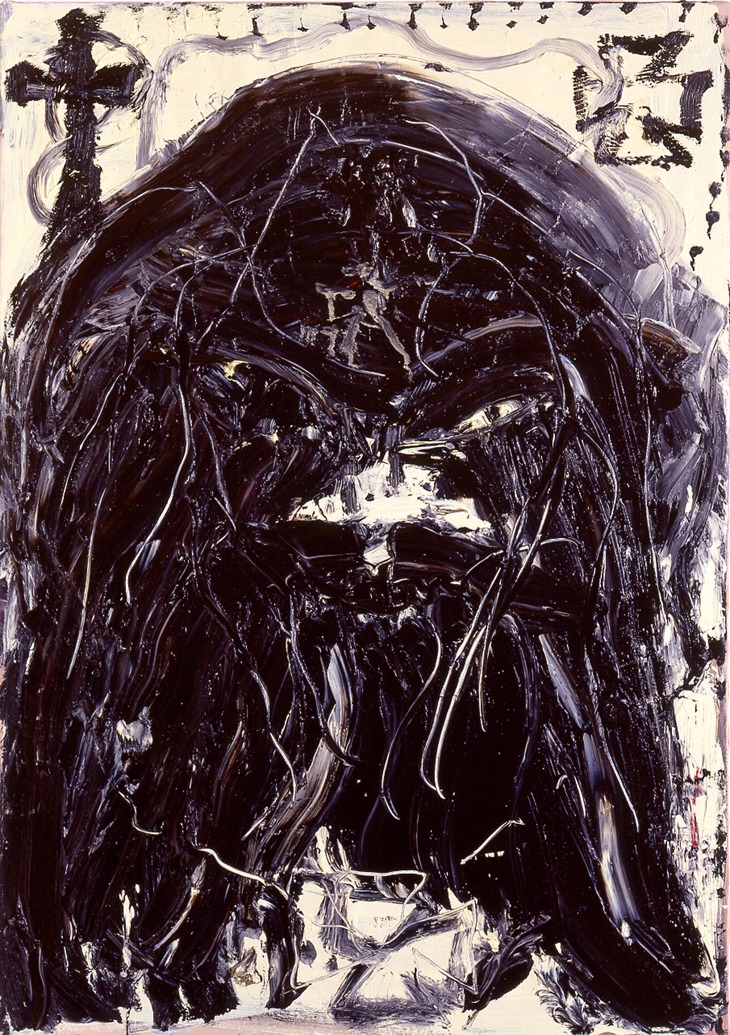
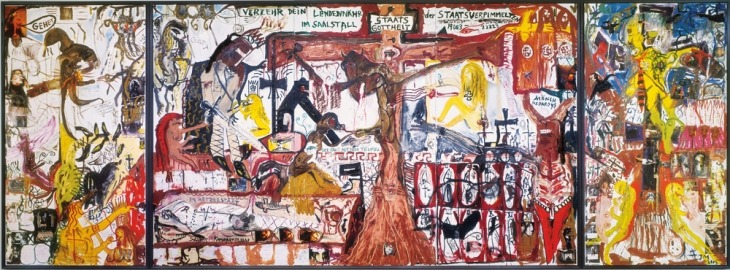
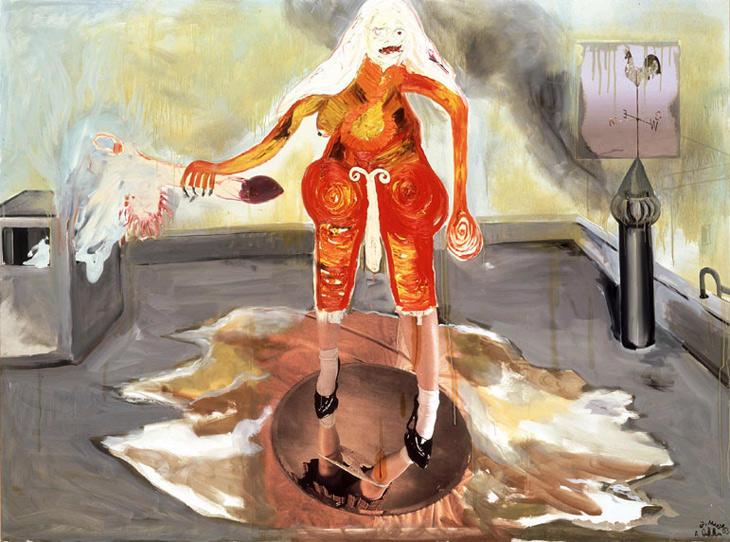
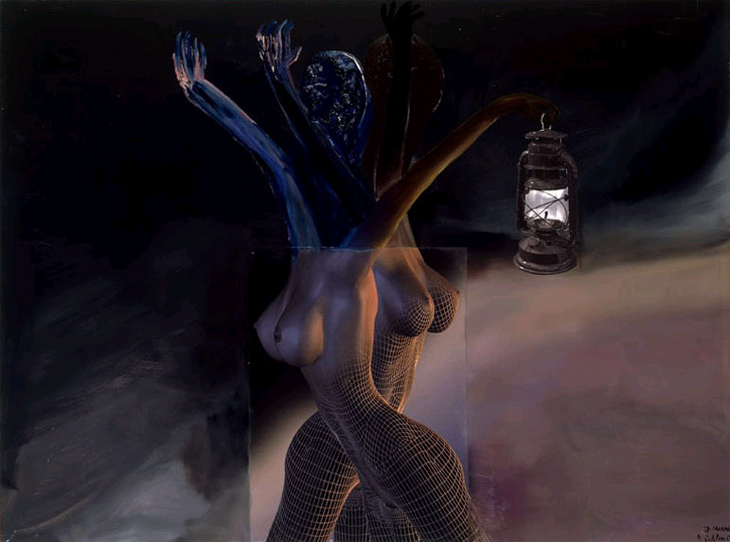
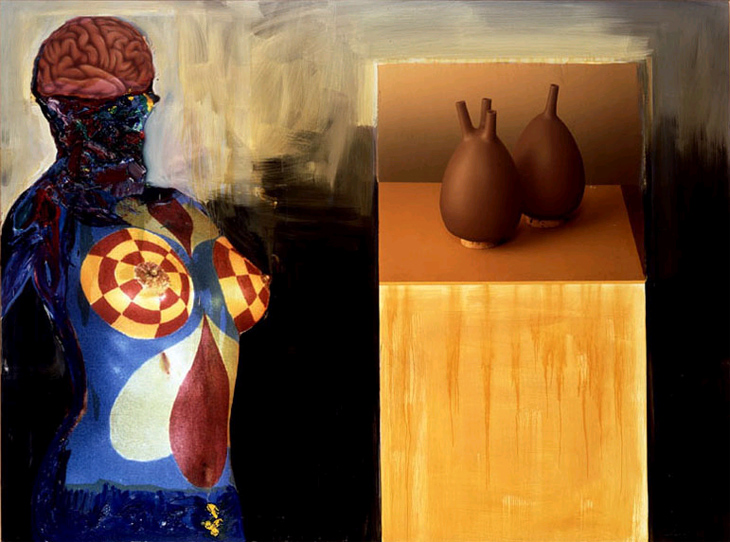
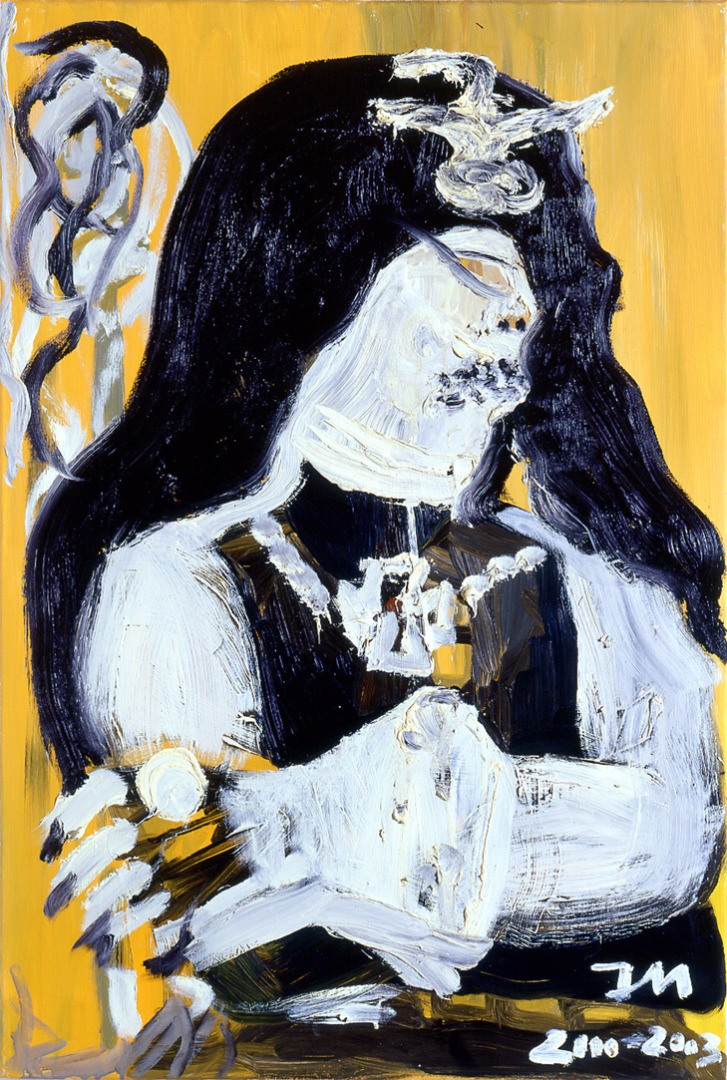
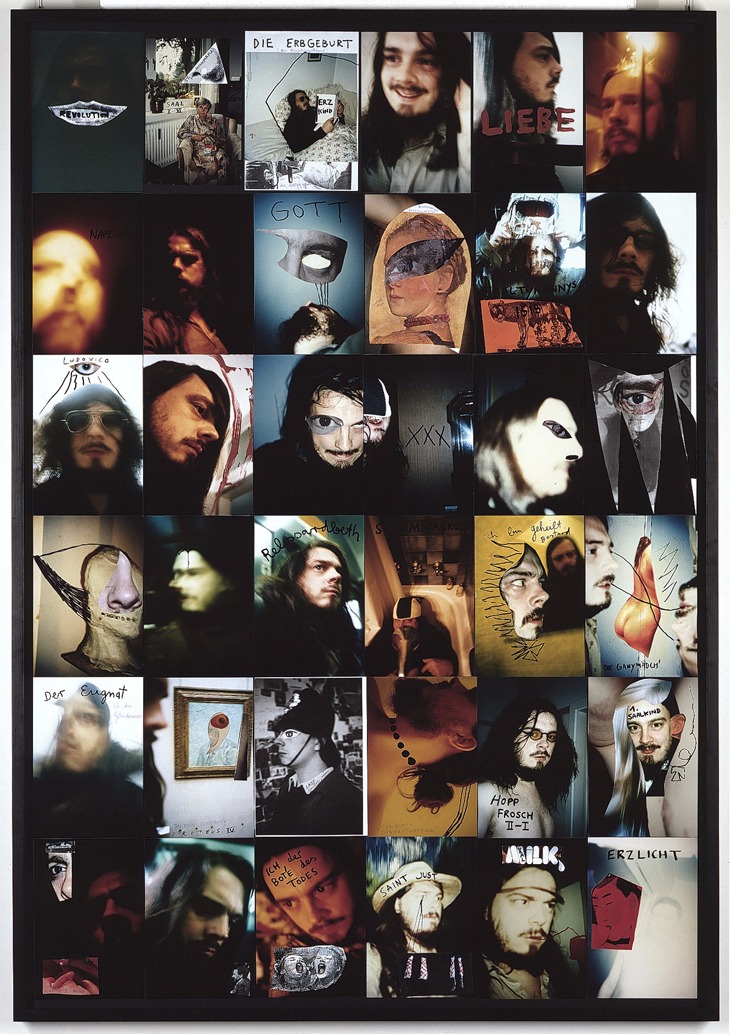
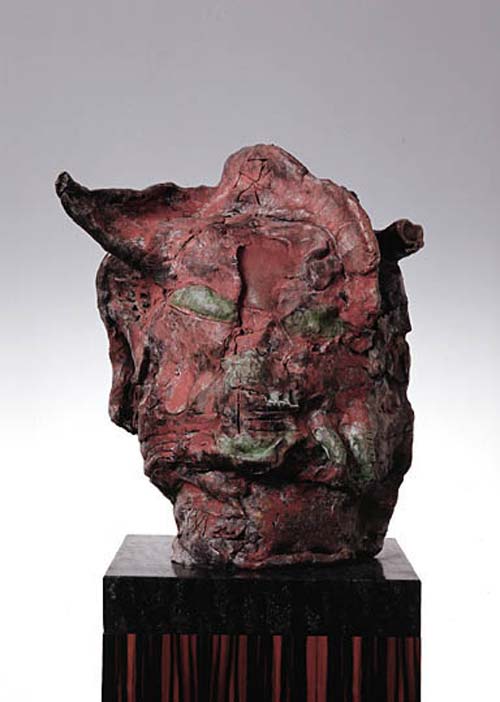
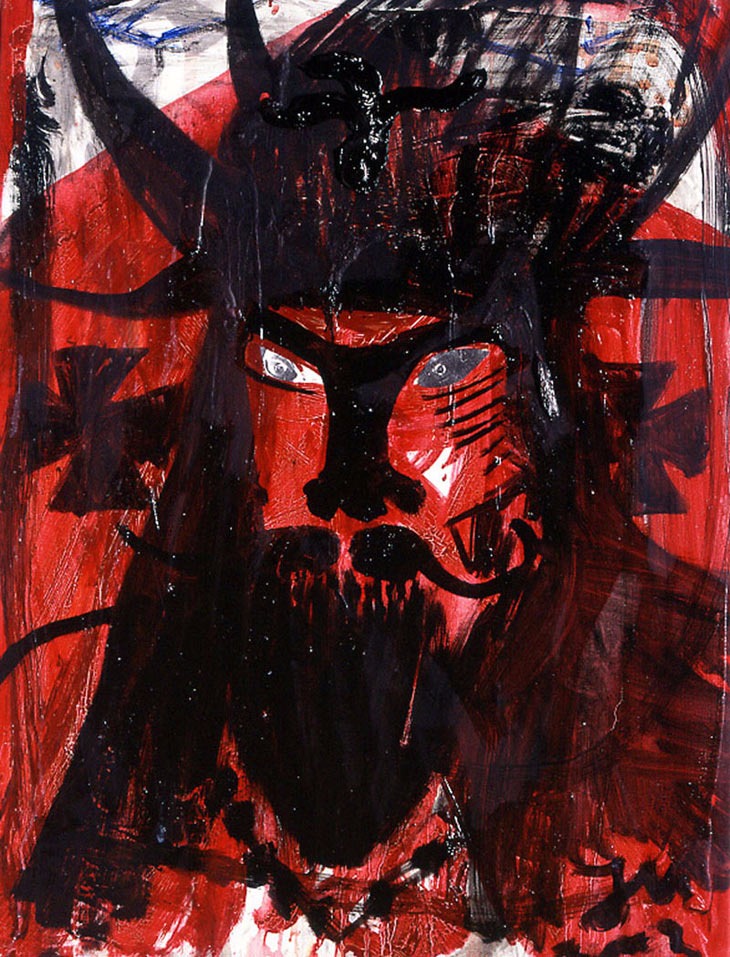
Jonathan Meese & Albert Oehlen
Jonathan Meese’s style of paint application is as forceful and savage as his media induced juju. In Requiemeese, his raw colours are squeezed straight from the tube and battered into resistant submission. Through this slack-handed process, Meese’s paint refutes illusion and retains its form as product, giving a pop and readymade edge to his brutal expressionism. In rendering a self-portrait as vampiric monster, Meese comically sucks the essence of painting dry: his impassioned gestures a by-product of play, the whimsical vice of a fictional artist/mad genius hell bent on cult status and world domination
In Stanley Kubrick, Jonathan Meese paints his idol as the monolithic ‘Lenin head’ of communist propaganda: visionary and revered harbinger of the utopian prospect. Meese renders his abstraction with a scatological out pouring of bile-like sentiment: cavernous blacks and polluted white smears engulf the canvas in a theatre of horror; putrid brown entrails spill out in cheap thrill spectacle. Meese uses abjection as an apocalyptic metaphor. Grotesque, sublime, and comically dumb, his painting follows the formulaic principles of science fiction film prophecy: envisioning the future as post-Armageddon landscape, where primitivism is embraced as the rational and finite social solution. Jonathan Meese draws from German Expressionism, a movement dominated by the horrors of war and social discontent, especially in painting and film. It was strongly concerned with the unique vision of the artist: a conception of artist-as-diviner that Meese readily embraces. In Catdim, Meese presents himself as an exotic oracle. His flat black mask sits with elegant form over his energetic gold colour-field, reminiscent of Emil Nolde’s Prophet. Meese infuses his images with immediacy and pathos, and his use of these values in a contemporary context lends authenticity to his B-movie alter-ego. Jonathan Meese’s sculptures pose as relics of undead ritual. Cast in bronze, these gargoyles seem to invite rather than ward off evil. In this series titled Solder of Fortune, Meese creates an army of vengeful ‘gods for hire’. Combining the exotica of theurgist religions with the titilation of late night ghoul films, Meese’s Soldier of Fortune “Iwan†(baby) is horrific and kitsch, preying on the deepest fears of media-fuelled imagination.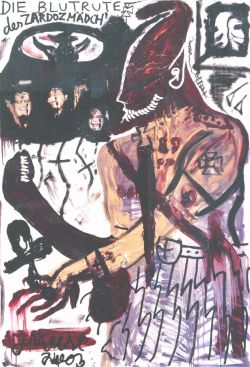
The Greeting is a ridiculous portrait of a lumpy gangly-armed housewife waving about a feather duster/penis, teetering on glamour model's legs. The render her almost obscenely repulsive, but the sexual delusion of the male gaze is inevitable: the artists' collage in a mirror to peek up her dress. Describing their merger as a courtly affair of awkward politeness punctuated by artistic embarrassment, Albert
Oehlen & Jonathan Meese unite forces as a way to expand both practice and dialogue. Like a conceptual game of tennis, an artwork is begun, and then bantered back and forth until it gains a life of its own. For the artists, it's a way to accept loosing control over a work, explore the possibility of spontaneous action and reaction, and stamp out self-indulgent excess like a bad habit. The end results are both breathtaking and funny. Storm cheekily sets computer-generated porn as the hot-bod for a wild-armed monstress: a goddess of violent temper and salvation. Jonathan Meese is a self-proclaimed cultural exorcist. In his performances, sculptures, and paintings he adopts a shamanistic role, schizophrenically channelling all manner of chaotic zeitgeist and psycho/media debris. In his self-portraits, Meese exaggerates his real-life ‘wild-man’ features, his image continuously mutating through a cast of characters – from demons to divas and superheroes – to develop potential narratives exploring the nature of power, corruption, and contemporary mythology. In Dr. Babysquawar Meese’s form morphs into a raging animal. Less image than projectile explosion of paint on canvas, Meese’s painting contains an unrestrained energy and brutal power; the bright colours and spastic rendering lend sarcasm to this false god. Albert Oehlen and Jonathan Meese both make paintings about failure: of the function of art, politics, and ideological systems. Working collaboratively, they explore these terrains in a hard-hitting and overtly humorous way. Situation creates a highly sexed still-life: a mangled-faced female figure reduced to tits and a brain. Dealing with issues of visual ideals and sexual politics, their cyborg superwoman is less an archetype of perfection than the suggestive abstract sculptures on the plinth beside her. Jonathan Meese confesses: "My biggest goal is not only to direct in Bayreuth but to make A Clockwork Orange II, Zardoz II, The Damned II . . . ". The essence of theatricality is central to Meese’s work. Deceptive in nature, it provides a simulated realm of falsification and absurdity, where form and idea become easily detached, and reassembled according to the artist’s own logic. Meese’s grand claims become effigies, redundant sequels to real historical epics. Drawing influence from Viennese Actionism, Meese finds catharsis in replicating ritual, rendering its powerful aura defunct in the process. In Lady Missmeesau, he dreams of himself as a burly diva, the star of Bayreuth’s famous Wagner festival. Quote from: Loose Canon: Matt Saunders on Jonathan Meese’s Mother Parsifal, posted on: www.artforum.com/inprint/id=8996 In Sankt Ich III, Meese collages together photos of himself in rockumentary-style layout: a devotional format of celebrity-as-god. Churning elements of his private life into readily identifiable stereotypes for public consumption, Meese’s snapshots disclose both the man and the myth. There’s Meese as smiling Jesus and evil-eyed Malcolm McDowell, burnt out hippie and visionary youth, scraggly-haired prophet and bare-chested sex symbol, master of darkness and apron-stringed mamma’s boy (beloved Mrs. Meese holds primary importance, top left!). Inter-spliced with graffiti scrawl and provocative clippings from magazines, Meese frames this pastiche with a formulaic sentimentality, mimicking the ephemera of teenage keepsakes. The Kampkopf Baby (Warmilk) is a massive mound of red flesh with shiny green eyes, and bite marks, a figure both animal and human. The title Kampkopf (Warhead) suggests a wounded and decapitated head of an evil beast. The artist’s base of makassa veneer presents the head as a valuable trophy. Jonathan
Meese’s work exploits cultural taboo. Appropriating
historical and media references. Meese parodies his own symbolism.
His paintings reduce the perception evil to the level of operatic
theatre: simulated horror plays out in clichéd formulas,
resounding in contemporary consciousness as benign fable and
gripping spectacle. In Dr. Phantomeese…, Meese
paints himself as a barbaric warlord, set against a blood
red ground emblazoned with iron crosses. Here, propaganda
associations are depleted to decorative motif; his character
is that of a villain in a fairytale, a slightly un-PC nemesis
of boys’ adventure. Following the cliché legacy of the horror genre, Jonathan Meese moulds his false gods with a timeless ferocity, using bronze casting to attest to their plausible immortality. Soldier of Fortune “Humphrey†(day) conveys an animistic spiritualism: the hellish face appears as ingenerate within the raw molten material, suggesting a malevolent presence at the very origin of nature.

